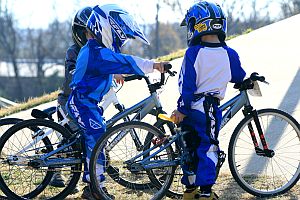The Joys of Swimming for Fun and Fitness
 With summer weather heating things up across much of the country, swimming is a great way to cool off and have some fun! But did you know that it’s also an excellent way to increase your fitness, help control your weight and improve your overall mood? Plus, swimming is a type of exercise that people of any age and physical ability can enjoy. It’s easy on the musculoskeletal system while at the same time providing a good aerobic workout.
With summer weather heating things up across much of the country, swimming is a great way to cool off and have some fun! But did you know that it’s also an excellent way to increase your fitness, help control your weight and improve your overall mood? Plus, swimming is a type of exercise that people of any age and physical ability can enjoy. It’s easy on the musculoskeletal system while at the same time providing a good aerobic workout.
Swim for Fun
Even among avid swimmers, boredom in the pool is one of the common reasons for losing interest in sport. While swimming laps in the pool may not seem like a recipe for fun, here are a few things you can do to add some variety to your in-water workouts.
- Plan your in-pool workout ahead of time and vary your activities so that variety is built-in.
- Swim with buddies who have the same water fun and fitness goals that you do.
- When swimming laps, do things to keep your mind engaged in your activity and help sharpen your technique. Counting how many strokes you need to complete a length of the pool and how quickly you can do it is one way to look for improvements. Experimenting with stroke length is another.
- If you have the option, change up the locations of your swimming workouts. A change of scenery—from an indoor pool to an outdoor one, or from a lake to the ocean—can make a big difference in how your workout feels.
- Add to your “playbook” of swimming drills. You can reach out to others or go online for suggestions to help mix things up.
- Learn some new strokes or make up some of your own. You might look silly doing it, but it adds to the experience!
Swim for Fitness
While swimming may not be as accessible as walking, running or even biking in some communities, it has distinctive health benefits that make it well worth the trip to a local pool. The organization that governs all swimming-related activities in the UK (called the ASA) compiled a report of scientific findings from all over the world about the health benefits of swimming. Some of them are truly striking. For instance, researchers have found that swimming regularly reduces men’s risk of dying early by a staggering 50% relative to those who run, walk or do no physical activity. Experts estimate that just two and a half hours per week of swimming can significantly reduce your risk of chronic disease.
A good all-around exercise, swimming involves both aerobic activity and working against resistance. Unlike most aerobic activities, however, swimming involves little in the way of jarring impact (like the shocks and jolts involved with running) and doesn’t require you to support your full body weight while doing it. When submerged up to your neck in water, your body weight is effectively reduced by 90 percent. As a result, overweight and obese people can get a good workout without placing large amounts of painful stress on the lower body’s muscles and joints. This removes a common deterrent to exercise for a large (and growing) part of the US population and suggests that swimming could be an attractive option for people trying to manage their weight.
Arthritis sufferers or those with musculoskeletal injuries can also benefit from swimming, since studies have shown that it improves range of motion without causing a worsening of symptoms such as pain and stiffness. In fact, according to the UK’s Chief Medical Officer, swimming as a form of exercise (as opposed to running or practicing other impact sports) can reduce your risk of osteoarthritis.
Beyond increasing fitness levels and helping to manage weight, swimming may provide a variety of other health benefits:
- Studies performed on people suffering from fibromyalgia have found that exercise performed in a warm pool reduced anxiety and depression and caused an improvement in mood.
- For older adults, swimming has been shown to improve quality of life and reduce the risk of osteoporosis. Post-menopausal women in particular are at increased risk of bone loss, and swimming provides a safe and effective form of the resistance exercise that is needed to maintain bone density.
- Pregnant women find that swimming strengthens their shoulder and abdominal muscles, which are put under increased stress during pregnancy. Obstetricians recommend swimming as a good form of exercise for most pregnant women, as it provides them with temporary relief from the extra weight they are carrying.
It’s hard to exaggerate the potential fitness benefits of swimming. Swimming helps to build cardiovascular fitness, muscle strength and endurance. It tones your muscles and helps to maintain healthy heart and lung function. It also improves flexibility, reduces blood pressure and alleviates stress. Whether in a community pool, at a nearby lake or in the ocean, swimming offers an ideal way for most people to keep fit that’s also easy on the body’s musculoskeletal system.
So get out there this summer and have some fun in the water!

 For many people, summertime just isn’t summertime without a barbecue! It’s a generations-old cultural phenomenon that combines three things American families love—food, family and fun!
For many people, summertime just isn’t summertime without a barbecue! It’s a generations-old cultural phenomenon that combines three things American families love—food, family and fun!

 America’s roads have become far safer across the past three decades. By just about any measure, travelers are much less likely to be injured or killed in a motor vehicle accident than they were in the late 1980s and early 1990s. And this is true even though we’re driving more miles each year!
America’s roads have become far safer across the past three decades. By just about any measure, travelers are much less likely to be injured or killed in a motor vehicle accident than they were in the late 1980s and early 1990s. And this is true even though we’re driving more miles each year!


